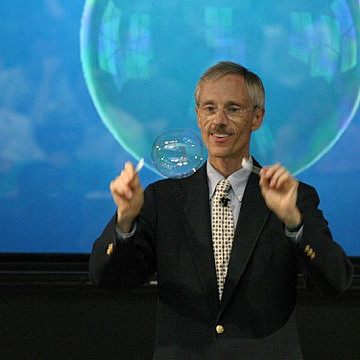News
The Beauty of Bubbles and the Joy of Mathematics
November 13, 2018
November 13, 2018
On November 27 at Southwestern University, renowned mathematics scholar Frank Morgan will present a departmental talk on the story and joy of mathematics. He will also deliver a public lecture and demonstration on soap bubbles, which have fascinated and puzzled mathematicians for centuries. Attendees can look forward to guessing contests, a game-show atmosphere with prizes, beguiling displays of bubble-blowing, and insights into the mathematical principles governing soap-bubble behavior.
Bubbles are far more than child’s play. You can find them almost everywhere, from waterfalls, waves, tree resin, lava, fish nests, and the flotation rafts of ocean-dwelling snails to mattresses, bread, glass, and fire extinguishers. Soap bubbles are also a source of wonder for mathematicians. “Bubbles are a naturally occurring, fun, and pretty example of a really interesting mathematical phenomenon or idea called optimization,” says Southwestern Assistant Professor of Mathematics John Ross. “One of the reasons that bubbles tend to be spherical when you blow them is because the soap film that’s created, just due to the laws of physics, tries to minimize its total surface tension, which is equivalent to minimizing its total surface area [while enclosing] a fixed volume of air inside.” The round shape resulting from a minimal surface area enveloping a constrained volume was mathematically proven optimal in 1884.
Students looking for a preview of Morgan’s talk can venture into Ross’s office to see this principle in action: his desk is topped by a number of bubble wands that demonstrate different levels of intricacy. The soap-bubble sculptures he creates with his handmade and 3D-printed wands are “beautiful and not intuitive at all,” he remarks.
As any Southwestern student or alum should expect, the applications of bubble-like optimization extend far beyond mathematics, affecting how we think in other disciplines. “This question of trying to find optimal objects, optimal shapes—these can be shapes with minimal surface area or that maximize some sort of equation—are of broad interest not only to pure mathematicians like us,” says Ross, “but also to applied mathematicians or economists or physicists. Anybody who uses math to try to solve some sort of problem [is] typically trying to find some sort of optimal object or optimal shape, and in many cases, you’re trying to optimize the given system trying to satisfy these conditions.” Classicists, for example, might remember when Dido, in Vergil’s Aeneid, is sold as much land as could be covered by the hide of a bull. Dido cleverly chooses a seaside parcel and outlines it with the hide, which she has cut into the narrowest-possible strips, tied end to end, to maximize the area of land within, and it becomes the iconic site of Carthage. Given such wide-ranging applications, then, Morgan’s talk promises to challenge audience members in various fields to consider how blowing bubbles might help us grasp complex ideas—including understanding the universe itself.
Morgan is the Webster Atwell Professor Emeritus of Mathematics at Williams College and editor-in-chief of Notices of the American Mathematical Society. He has variously taught at such campuses as Rice University, Stanford University, and Princeton University, and this fall, he is a visiting professor of mathematics at Baylor University. Morgan specializes in geometry, minimal surfaces, geometric measure theory, and the calculus of variations. “He’s a well-known professor who has done a lot for the mathematical community,” says Professor and Chair of Mathematics Fumiko Futamura. Ross agrees: “Frank Morgan is one of the mathematicians who I look up to a great deal in the fields of geometric measure theory and minimal surfaces,” he says. “He’s done a lot of amazing expository work in [explaining] the mathematics of minimal surfaces to audiences. It’ll be a very entertaining, informative, and inspiring talk.”
The half-hour departmental lecture, “Sharing the Joy of Mathematics,” will take place in Mood–Bridwell Hall 107 at 4:00 p.m. on November 27. The hourlong talk and demonstration, “Soap Bubbles and Mathematics,” is open to the general public and will follow in Olin Hall 105 at 6:00 p.m. Light refreshments will be available. The event is sponsored by the Department of Math and Computer Science.















